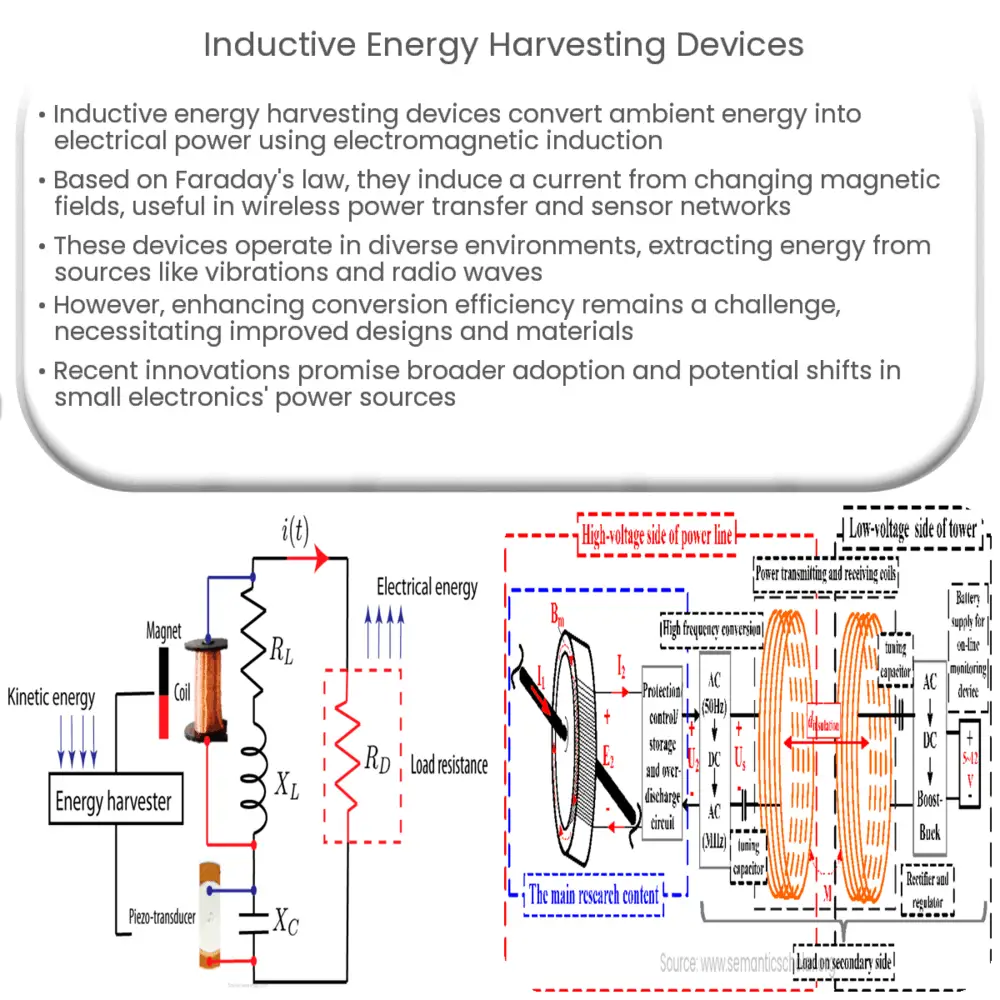Discover the potential of inductive energy harvesting devices in powering small electronic devices. Learn about their applications and advantages.

Inductive Energy Harvesting Devices
Energy harvesting has emerged as a promising solution to power small electronic devices in various applications where access to conventional power sources is limited or impractical. Inductive energy harvesting devices are a type of energy harvesting technology that utilizes electromagnetic induction to convert ambient energy into usable electrical power.
The principle behind inductive energy harvesting devices is based on Faraday’s law of electromagnetic induction, which states that a changing magnetic field induces an electric current in a nearby conductor. In the context of energy harvesting, this involves using a magnetic field to induce a current in a coil or conductor, which is then rectified and stored for later use.
One common application of inductive energy harvesting devices is in wireless power transfer systems. These systems use inductive coupling to transfer power wirelessly between a transmitter and a receiver. The transmitter generates an oscillating magnetic field, which is picked up by the receiver’s coil, inducing a current that can be used to power the device.
Another application of inductive energy harvesting is in the field of sensor networks. In many sensor network applications, such as environmental monitoring or structural health monitoring, it is often impractical or costly to replace batteries in large numbers of sensor nodes. Inductive energy harvesting provides an alternative solution by enabling the sensors to harvest energy from their surrounding environment, such as vibrations, electromagnetic waves, or ambient light.
One key advantage of inductive energy harvesting devices is their ability to operate in a wide range of environments and conditions. They can harvest energy from various sources, including mechanical vibrations, thermal gradients, and radio frequency waves. This versatility makes them suitable for a wide range of applications, from wearable electronics to smart infrastructure.
However, there are some challenges associated with inductive energy harvesting devices. One major challenge is the efficiency of energy conversion. Optimizing the conversion efficiency requires careful design of the coil, magnetic materials, and circuitry to maximize the power harvested from the ambient energy source.
In conclusion, inductive energy harvesting devices offer a promising solution for powering small electronic devices in applications where conventional power sources are impractical. Their ability to harvest energy from various sources and their versatility make them a viable option for a wide range of applications. With further advancements in design and efficiency, inductive energy harvesting devices have the potential to revolutionize the way we power small-scale electronics in the future.
Inductive Energy Harvesting Devices
Energy harvesting has emerged as a promising solution to power small electronic devices in various applications where access to conventional power sources is limited or impractical. Inductive energy harvesting devices are a type of energy harvesting technology that utilizes electromagnetic induction to convert ambient energy into usable electrical power.
The principle behind inductive energy harvesting devices is based on Faraday’s law of electromagnetic induction, which states that a changing magnetic field induces an electric current in a nearby conductor. In the context of energy harvesting, this involves using a magnetic field to induce a current in a coil or conductor, which is then rectified and stored for later use.
One common application of inductive energy harvesting devices is in wireless power transfer systems. These systems use inductive coupling to transfer power wirelessly between a transmitter and a receiver. The transmitter generates an oscillating magnetic field, which is picked up by the receiver’s coil, inducing a current that can be used to power the device.
Another application of inductive energy harvesting is in the field of sensor networks. In many sensor network applications, such as environmental monitoring or structural health monitoring, it is often impractical or costly to replace batteries in large numbers of sensor nodes. Inductive energy harvesting provides an alternative solution by enabling the sensors to harvest energy from their surrounding environment, such as vibrations, electromagnetic waves, or ambient light.
One key advantage of inductive energy harvesting devices is their ability to operate in a wide range of environments and conditions. They can harvest energy from various sources, including mechanical vibrations, thermal gradients, and radio frequency waves. This versatility makes them suitable for a wide range of applications, from wearable electronics to smart infrastructure.
However, there are some challenges associated with inductive energy harvesting devices. One major challenge is the efficiency of energy conversion. Optimizing the conversion efficiency requires careful design of the coil, magnetic materials, and circuitry to maximize the power harvested from the ambient energy source.
In recent years, significant progress has been made in the development of inductive energy harvesting devices. Researchers are exploring innovative designs and materials to enhance the efficiency and performance of these devices. Advances in miniaturization techniques have also made it possible to integrate inductive energy harvesting technology into smaller and more compact devices, opening up new possibilities for their widespread adoption.
In conclusion, inductive energy harvesting devices offer a promising solution for powering small electronic devices in applications where conventional power sources are impractical. Their ability to harvest energy from various sources and their versatility make them a viable option for a wide range of applications. With further advancements in design and efficiency, inductive energy harvesting devices have the potential to revolutionize the way we power small-scale electronics in the future. As research and development continue, we can expect to see more efficient and compact inductive energy harvesting devices that contribute to the growth of sustainable and self-powered technologies.

